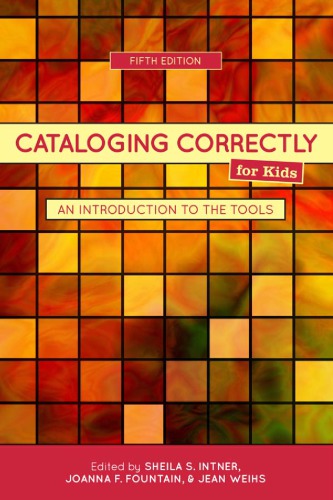

Most ebook files are in PDF format, so you can easily read them using various software such as Foxit Reader or directly on the Google Chrome browser.
Some ebook files are released by publishers in other formats such as .awz, .mobi, .epub, .fb2, etc. You may need to install specific software to read these formats on mobile/PC, such as Calibre.
Please read the tutorial at this link. https://ebooknice.com/page/post?id=faq
We offer FREE conversion to the popular formats you request; however, this may take some time. Therefore, right after payment, please email us, and we will try to provide the service as quickly as possible.
For some exceptional file formats or broken links (if any), please refrain from opening any disputes. Instead, email us first, and we will try to assist within a maximum of 6 hours.
EbookNice Team

Status:
Available0.0
0 reviews(Ebook) Cataloging Correctly for Kids an Introduction to the Tools 5th Edition by Sheila S Intner, Joanna F Fountain - Ebook PDF Instant Download/Delivery: 9780838935897 ,0838935893
Full download (Ebook) Cataloging Correctly for Kids an Introduction to the Tools 5th Edition after payment

Product details:
ISBN 10: 0838935893
ISBN 13: 9780838935897
Author: Sheila S Intner, Joanna F Fountain
(Ebook) Cataloging Correctly for Kids an Introduction to the Tools 5th Edition Table of contents:
Chapter 1: Guidelines for Standardized Cataloging for Children
BACKGROUND
SCOPE
GUIDELINES FOR DESCRIPTION AND ACCESS
FIGURE 1.1
FIGURE 1.2
FIGURE 1.3
FIGURE 1.4
FIGURE 1.5
LOCAL IMPLEMENTATION
RESOURCES
Chapter 2: How Children Search
IDENTIFYING THE PROBLEMS
PROVIDING SOLUTIONS
CONCLUSION
NOTES
Chapter 3: Cataloging Correctly Using AACR2 and MARC 21
CATALOGING STRATEGIES
CATALOGING RULES
SHARED CATALOGING AND THE RISE OF MARC
THE CATALOGING PROCESS
FIGURE 3.1
FIGURE 3.2
FIGURE 3.3
MORE ABOUT MARC
FIGURE 3.4A
FIGURE 3.4B
FIGURE 3.5
FIGURE 3.6
FIGURE 3.7
FIGURE 3.8
FIGURE 3.9
FIGURE 3.10
FIGURE 3.11
FIGURE 3.12
CONCLUSION
RESOURCES
NOTES
Chapter 4: Copy Cataloging Correctly
WHY COPY CATALOGING?
SOURCES OF MARC RECORDS
SEARCHING FOR MARC RECORDS
FIGURE 4.1
SEARCH QUALIFIERS
MATCHING MARC RECORDS AGAINST RESOURCES
FIGURE 4.2
FIGURE 4.3
FIGURE 4.4
MATCHING TO CIP AND TO ENCODING LEVEL 3 RECORDS
FIGURE 4.5
FIGURE 4.6
CHOOSING AMONG MARC RECORDS
EDITING MARC RECORDS
FIGURE 4.7
EDITING MARC RECORDS—SOME EXAMPLES
DOWNLOADING AND UPLOADING
FIGURE 4.8
BACK TO THE BEGINNING
NOTES
Chapter 5: Cataloging Correctly(Someday) Using RDA
Why RDA?
WHAT SHOULD BIBLIOGRAPHIC RECORDS DO?
IMPROVING THE ORGANIZATION OF BIBLIOGRAPHIC DATA
MORE ABOUT MULTIPLE VERSIONS
WORKS, EXPRESSIONS, MANIFESTATIONS, AND ITEMS—WHAT ARE THEY?
A FEW WEMI POSSIBILITIES
FIGURE 5.1
FIGURE 5.2
FIGURE 5.3
FIGURE 5.4
FIGURE 5.5
FIGURE 5.6
FIGURE 5.7
WEMI ENTITIES
FIGURE 5.8
SEPARATE SETS OF RDA ELEMENTS FOR EACH WEMI ENTITY
FIGURE 5.9
FIGURE 5.10
GROUP 1 ENTITIES, GROUP 2 ENTITIES, AND GROUP 3 ENTITIES
FIGURE 5.11
FRAD and FRSAD
RDA STRUCTURE AND LAYOUT
FIGURE 5.12
AACR2 AND RDA: SIMILARITIES AND DIFFERENCES
RDA and MARC
FIGURE 5.13
CAUTIONARY WORDS
NOTES
Chapter 6: Authority Control and Kids’ Cataloging
WHAT IS AUTHORITY CONTROL?
WHY IS AUTHORITY CONTROL IMPORTANT?
AUTHORITY CONTROL AND CHILDREN’S CATALOGING
DECISIONS IN AUTHORITY CONTROL
CREATING THE AUTHORITY FILE
MAINTAINING THE AUTHORITY FILE AND BIBLIOGRAPHIC RECORDS
CONCLUSION
NOTES
Chapter 7: Using LC ’s Children’s Subject Headings in Catalogs for Children and Young Adults: Wh
CONCLUSION
NOTES
RESOURCES
Chapter 8: Sears List of Subject Headings
COMPARING SEARS and LCSH
FEATURES of the SEARS LIST
CONCLUSION
RESOURCES
Chapter 9: Dewey Decimal Classification
EDITIONS of the DDC
ABRIDGED WEBDEWEY, WEBDEWEY, and MAPPED TERMINOLOGY
CHOICE OF NUMBER
NUMBER BUILDING AND BUILT NUMBERS
SEGMENTATION IN DDC NUMBERS
DDC AND MARC 21
DEWEY IN MANY LANGUAGES
CONCLUSION
RESOURCES
NOTES
Chapter 10: Cataloging Nonbook Materials
DESCRIPTION AND ACCESS
FIGURE 10.1
SUBJECT ANALYSIS: INTRODUCTION
SUBJECT HEADING ASSIGNMENT
CLASSIFICATION AND CALL NUMBERS
MARC CODING
OTHER CONSIDERATIONS
CONCLUSION
RESOURCES
HELPFUL WEBSITES
NOTES
Chapter 11: How the CIP Program Helps Children’s Librarians
PROGRAM DESCRIPTION
CIP AND LOCAL CATALOGING
SERVICE BENEFITS
RECENT RESEARCH
CONCLUSION
RESOURCES
NOTE
Chapter 12: Cataloging for Kids in the Academic Library
CATALOGING OPTIONS
BIBLIOGRAPHIC RECORDS
USEFUL FIELDS
CONCLUSION
RESOURCES
NOTES
Chapter 13: Cataloging for Non-English-Speaking and Preliterate Children
CATALOGING CODE
UNIFORM TITLES
SUBJECT HEADINGS
VISUAL CATALOGS
CONCLUSION
NOTES
Chapter 14: Automating the Children’s Catalog
PURCHASING AN AUTOMATION SYSTEM
RETROSPECTIVE CONVERSION
OBTAINING A MARC DATABASE
PREPARING FOR RETROSPECTIVE CONVERSION
POST-CONVERSION CLEANUP
ONGOING MAINTENANCE
CONTRIBUTING TO A UNION CATALOG
CONCLUSION
RESOURCES
Chapter 15: Vendors of Cataloging for Children’s Materials
CALL NUMBERS
SUBJECT HEADINGS
READING PROGRAMS
SERIES
PHYSICAL PROCESSING
OTHER SERVICES
ADDITIONAL CONCERNS
POST-SELECTION ISSUES
DIRECTORY OF VENDORS
Bibliography
Glossary of Abbreviations
Contributors
Subject Index
Figure Index
You may also be interested in
People also search for (Ebook) Cataloging Correctly for Kids an Introduction to the Tools 5th Edition:
categorizing for kindergarten
cataloging or cataloguing spelling
cataloging rules
cataloging examples
is cataloging a word
Tags: Sheila S Intner, Joanna F Fountain, Cataloging Correctly, Tools